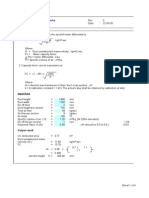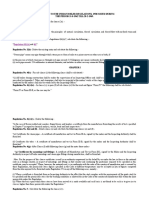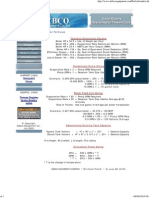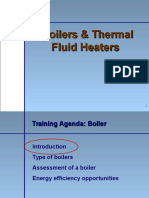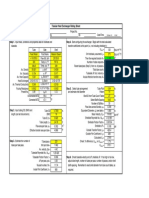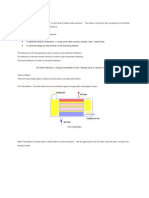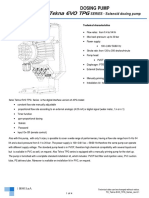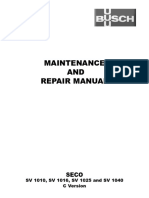Spec Boiler
Spec Boiler
Uploaded by
Achmad MakmuriCopyright:
Available Formats
Spec Boiler
Spec Boiler
Uploaded by
Achmad MakmuriCopyright
Available Formats
Share this document
Did you find this document useful?
Is this content inappropriate?
Copyright:
Available Formats
Spec Boiler
Spec Boiler
Uploaded by
Achmad MakmuriCopyright:
Available Formats
STEAM BOILER SYSTEM
Capacity: 16 Ton/h
1. Construction
Combi Steam Boiler System, Water Tube and Fire Tube with Water Cooled Combustion
Chamber Furnace. Manual balance draIt system into the Iurnace, Automatic / manual Iuel
Ieeding system Ior baggage
. 0n0ral boil0r data
Model : CSB 16T-8
Type : Horizontal combi 3 phase Iire tube and water tube steam boiler
Standard design : American Standard (ASME Code)
Steam output : 16000 Kg/h. oI saturated steam
Thermal capacity : 1056x10
4
Kcal/h
Design pressure : 10 Kg/cm
2
G
Test pressure : 10 Kg/cm
2
G
Max working pressure : 8 Kg/cm
2
G
Heating surIace:
- Radiant heating surIace : 98 M
2
(approx)
- Convection heating surIace : 550 M
2
(approx)
Fuel : Baggage
Materials calculation
& construction : According to ASME sec I, Power Boiler
CertiIication : DPNKK (Depnaker RI)
Material speciIication
- Boiler plate : HII DIN 17155 / SB-42 JIS G-3103
- Boiler tubes : ST.35,8-I / STB 340 S-H
Welding methods : According to ASME sec IX
Examinations methods : According to ASME sec V (X-Ray, P.T. MPT)
Test methods : Water Pressure Test
Electric : AC 50Hz - 380 Volt
- 380V : Ior motors (3
)
- 220V : Ior controllers & instruments. Controller signal
. Scop0 of Works
Boiler drum
Materials:
Body shell : Boiler plate DIN 17155 HII / SB-42 JIS G-3103
Tube plate : Boiler plate DIN 17155 HII / SB-42 JIS G-3103
Fire tube : Boiler Tube DIN 17175 Gr I / ST 35.8-I / STB 340 S-H
Nozzle connection : Black seamless pipe Sch40
Flange joint : Din PN16 Std
Boiler support : WI300x150x6.5x9mm, Siku L100x100x10mm
Isolation : Glass wool D32 Zincalume cover
Water tube Iurnace
Furnace chamber Ior boiler complete with Iire grate, rooster and Iire brick
Materials:
Water tube : Boiler Tube DIN 17175 Gr I / ST 35.8-I / STB 340 S-H
Header : Black seamless pipe Sch40 ASTM A106 Gr-B
Flange joint : Din PN16 Std
Membrane wall : Plate Ms/Ss400
Ash box : Plate Ms/Ss400
ReIractory : Castable reIractory
Grate : Plat grate castable reIractory
Isolation : Glass wool D32 Zincalume cover
Induce draIt Ian
Type : Radial turbo Ian
Capacity : 63000 m
3
/h
Static pressure : 2240 Pa
Materials:
ShaIt : ST60
Impeller and casing : Plate Ms/Ss400
Bearing : Plummer block bearing 'SKF
Power : 75Kw/100Hp, 3Phase, 380-660Volt 50Hz
Force draIt Ian
Type : Radial turbo Ian (direct couple)
Capacity : 1800 m
3
/h
Static pressure : 2000 Pa
Material : Impeller and casing plate Ms/Ss400
Power : 22Kw/30Hp, 3Phase, 380-660Volt 50Hz
Over Iire Ian
Type : Radial high pressure blower
Material : Impeller and casing plate Ms/Ss400
Power : 2.2Kw/3Hp, 3Phase, 220-380Volt 50Hz
Quantity : 2 Unit
Chimney / ducting
Size : 0x24m Height
Materials:
Body shell : Plate Ms/Ss400
Support : Steel wire rooI
Complete with Chimney ladder, platIorm & Support lightening protection
(excluded lightening protector)
Ash collector
Type : Cyclone ash collector
Cyclone : Size 2240x6990mm Height
Material : Plate Ms/Ss400
Support : WI 150x75x5x7mm, angle bar L80x80x8mm, L60x60x6mm
Quantity : 2 (two) units
Boiler Ieed pump
Type : 'GrundIos Vertical multistage pump
Capacity : 20 m
3
/h
Head : 100 M
Quantity : 2 (two) units (1 units operation 1 unit stand by)
Water level gauge
Brand : Diesee ex Germany
Size : 300 mm
Quantity : 2 (two) unit
SaIety valve
Brand : Leser ex Germany
Size : Dn65 Pn16
Quantity : 2 (two) units
Boiler control panel
Electric panel control with automatic pressure witch control & water level control Ior
boiler operation
Materials:
Contactor / overload : ex Japan
Box panel : Plate Ms with powder coating
Cable installation : Type NYY cable
Cable control : Type NYYHY cable
Feed water tank
Type : Horizontal
Capacity : 12 m
3
Diameter : 1900x4500mm Length
Materials:
Body shell : Plate Ms/Ss400
Support : WI 200x100x5.5x8mm, Angle bar L70x70x7mm
Condensate tank
Type . Jertical
Capacity . 15 m
3
Diameter . /- 2500x3000mm
Material . Plate Ms/Ss400
Boiler interconnecting pipe c/w insulation
Only up to main steam, header and Ieed water tank
Valve and Appliance
- Main steam valve Ior boiler 1 Pcs
- Feed stop valve 1 Pcs
- Feed non return valve 1 Pcs
- Drain stop valve 3 Pcs
- Blow down valve (ball valve) 3 Pcs
- Venting valve 1 Pcs
- Condensate pump
- Boiler platIorm
- Feed water control
- Low water shut down switch alarm
- Automatic pressure switch
Main steam header
Diameter : 20x1500mm
Auxiliary nozzle : maximum 5 pcs
Insulation : Glass wool Aluminum cover t0.5mm
Pressure gauge : 6 range 0-10 bar
Complete automatic condensate drain with steam trap
Boiler operation license (Iabrication certiIication) Irom Depnaker RI
Boiler Foundation
Scope oI customer with drawing supply Irom us
O Excluded : Water storage tank, water soItener system, & water treatment
system
00ding Syst02
O Fabrication and installation Automatic Ieeding system Ior Steam boiler system with Scrapper
conveyor system
a. Feeding system
Type : Scrapper conveyor
Capasitas : 3 Ton/jam
Qty : 2 Unit
&kuran.
Panfang . /- 6000 mm
Lebar . 400 mm
Materials:
Casing : Plate Ms/Ss400 t4.5mm
Chain : Chain Rs80
Power screw : 2.2Kw/3Hp 220-380Volt. with Electromotor 'Teco
Gear box 'Chenta ex Taiwan
b. Panel control
Electric panel control with Automatic / manual Ior automatic Ieeding system operation
Materials:
Contactor / overload : ex Japan
Box panel : Plate Ms with powder coating
Cable installation : Type Nyyhy cable
Economizer
September 10, 2008
oleh malikhizbullah
Pada sistem pembangkit tenaga uap (steam power plant), salah satu cara untuk
meningkatkan eIisiensi tersebut adalah dengan melengkapi unit heat exchanger. Salah
satunya yaitu menggunakan peralatan pesawat pemanas air pengisi ketel yang biasa
disebut ekonomizer. Ekonomi:er merupakan alat yang digunakan untuk memanaskan air
pengisi ketel (feed water) sebelum masuk drum ketel dengan memanIaatkan panas yang
terkandung dalam gas buang. Karena prosentase terbesar kehilangan energi pada ketel
secara umum ada pada gas buang cerobong. Diharapkan air masuk ketel yang menerima
transIer panas dari gas buang menjadi lebih panas sehingga pembentukan uap lebih cepat.
Pemasangan heat exchanger ini akan membantu meningkatkan eIisiensi ketel. Akibatnya
pemanIaatan ampas akan berlangsung lebih eIisien dan pemakaian bahan bakar suplesi
dapat dihindari sehingga biaya produksi dapat ditekan.
2.3.1 Combustion Theory1
The complete combustion of bagasse can be thought of as occurring
in two stages: primary and secondary combustion. Primary combustion refers to the
physical and chemical changes occurring on the fuel bed. t consists of drying,
devolatilization, ignition, and burning of the bagasse. Secondary combustion refers
to the oxidation of the gases and particulate matter released by primary combustion.
Secondary combustion is aided by high temperature, sufficient air and turbulence in
the gas stream. The turbulence must be intense and last long enough to ensure
adequate mixing at elevated temperatures.
Time, temperature, turbulence, and air require a delicate balance for
complete combustion. A disturbance in one or more of these variables can reduce
combustion efficiency and result in measurable increases in emissions of carbon
monoxide (CO) and other organic compounds (i.e., the products of incomplete
combustion). As a class, these organic compound emissions are generally
measured either as volatile organic compounds (VOCs) or total organic compounds
(TOCs).
2.3.2 Boiler Operating Procedures2
x2i -xi
Boiler operating procedures can influence uncontrolled emissions from
bagasse-fired boilers. First, like other waste-fired boilers, bagasse boilers may use
auxiliary fuels for start-up. Because fuel oil is usually the start-up fuel, the initial
sulfur dioxide (SO2) and nitrogen oxides (NOx) emissions are higher than when
bagasse alone is fired. The duration of startup is typically up to 8 hours. During this
period, particulate matter (PM) emissions may increase due to poor combustion
conditions in the boiler while it is cold. n most areas, bagasse boilers are started up
once at the start of the harvest season and are not shut down until the end of the
season, unless it is absolutely necessary.
n Hawaii, the boilers are operated differently in that they are shut down on
weekends unless they are cogenerating electricity. For economic reasons,
cogeneration boilers typically operate continuously nearly year round. Also,
bagasse-fired boilers in Hawaii are generally more efficient than in other areas due
to lower fuel moisture contents, larger boiler sizes, and the placement of the stoker
feed system higher above the grate to increase suspension burning.
Second, most bagasse boilers may cofire an auxiliary fuel (normally fuel oil or
natural gas) at times to produce the total energy needed for the facility to sustain
good combustion with wet bagasse. As is the case during startup, combined oil and
bagasse firing will increase SO2 and NOx emissions. Auxiliary fuel is used whenever
additional heat input is required. f the supply of bagasse to the boiler is interrupted,
auxiliary fuel will be used to provide up to 100 percent of the heat input of the boiler.
During these periods, SO2 and NOx emissions will increase. Facilities burning
bagasse normally attempt to keep auxiliary fuel use to a minimum for economic
reasons. Typically, less than 15 percent of the total annual fuel heat input into the
boiler comes from fossil fuels. Bagasse-fired boilers in Hawaii which cogenerate
electricity generally fire the largest amounts of fossil fuels because they are
operated outside of the harvest season.
f boilers are undersized, soil brought in with the cane can become physically
entrained by the high velocity of the combustion gases.1 Soil characteristics such as
particle size can affect the magnitude of PM emissions from the boiler. Mill
x2ii-xii
operation can also influence the bagasse ash content by not properly washing and
preparing the cane.
Quote:
Conveyor Baggase Drier cap 8 ton/hr and can reduce Moisture Content Irom: 50 to 30
Please send to us oIIering - incl: speciIication, material, design, etc and... THE PRICE (Iob or ciI
surabaya east java) exactly soonly
thx
Your FaithIully
Makmuri
http://www.alvanblanch.co.uk
You might also like
- Wa350 1Document781 pagesWa350 1Ravinder Singh91% (23)
- Plumbing Engineering and Design Handbook of Tables-American Society of Plumbing Engineers (ASPE) (2008)Document2,015 pagesPlumbing Engineering and Design Handbook of Tables-American Society of Plumbing Engineers (ASPE) (2008)eskandar66100% (1)
- Deutz 2011 Service TrainingDocument62 pagesDeutz 2011 Service TrainingGabriela Clavijo Prada100% (10)
- Excel Sheet For Fuel UsageDocument7 pagesExcel Sheet For Fuel UsageAnonymous Xi0MsWMpNo ratings yet
- Designing of A TPH Fire Tube Boiler: December 2019Document25 pagesDesigning of A TPH Fire Tube Boiler: December 2019Hélder PascoalNo ratings yet
- Pressure Testing Request FormDocument1 pagePressure Testing Request FormSyed Mahmud Habibur RahmanNo ratings yet
- FD Aerofoil 1590x2640Document4 pagesFD Aerofoil 1590x2640Prakash WarrierNo ratings yet
- Glaxo Vol IDocument164 pagesGlaxo Vol IPrakash WarrierNo ratings yet
- Continuum Mechanics For EngineersDocument53 pagesContinuum Mechanics For Engineersshushant kumarNo ratings yet
- EconomiserDocument15 pagesEconomiserjadgugNo ratings yet
- Single Drum BoilerDocument12 pagesSingle Drum BoileravgpaulNo ratings yet
- The Indian Boilers Act 1923Document16 pagesThe Indian Boilers Act 1923Anand Swami100% (1)
- Casestudy On Ricehusk Firing in CFBC by R.nagarajaprasathDocument8 pagesCasestudy On Ricehusk Firing in CFBC by R.nagarajaprasathNagarajaprasath PremNo ratings yet
- Final Energy Balance-Vizag DT 9-6-18Document6 pagesFinal Energy Balance-Vizag DT 9-6-18SUBHOMOYNo ratings yet
- Amendments To The Indian Boiler RegulationsDocument42 pagesAmendments To The Indian Boiler RegulationsAayush LawrenceNo ratings yet
- G9B - Brochure - Marine Boiler Soot Blowers PDFDocument6 pagesG9B - Brochure - Marine Boiler Soot Blowers PDFFadzil NorNo ratings yet
- DraughtDocument33 pagesDraughtNipun SabharwalNo ratings yet
- Tech Spec Bhel PheDocument55 pagesTech Spec Bhel PheYasmin 2021No ratings yet
- Drawing Boiler PartsDocument1 pageDrawing Boiler PartsAnonymous FZs3yBHh7No ratings yet
- Boiler Riser TubesDocument8 pagesBoiler Riser TubesSachinNo ratings yet
- S.V Reg. in Asme TDP 1, Asme Sec 1, b31.1Document9 pagesS.V Reg. in Asme TDP 1, Asme Sec 1, b31.1K.S.MAYILVAGHANANNo ratings yet
- BPVC I p-2Document2 pagesBPVC I p-2Ingeniería Thermo PressionNo ratings yet
- DheerajDocument7 pagesDheerajSaksham KakarNo ratings yet
- Cost Air CoolersDocument1 pageCost Air CoolersSteve WanNo ratings yet
- Economizer Recirculation For Low-Load Stability in Heat Recovery Steam GeneratorDocument10 pagesEconomizer Recirculation For Low-Load Stability in Heat Recovery Steam GeneratorknsaravanaNo ratings yet
- Spray-Type Deaerator: Installation and Operating Service ManualDocument19 pagesSpray-Type Deaerator: Installation and Operating Service Manualak_thimiriNo ratings yet
- Boiler FormulasDocument1 pageBoiler FormulasAnvar PaNo ratings yet
- Combustion and Flame: AnswerDocument5 pagesCombustion and Flame: Answerniranjan bhagatNo ratings yet
- Inspecton ProcedureDocument3 pagesInspecton ProcedureSanthosh ReddyNo ratings yet
- Boiler Circulation SystemDocument32 pagesBoiler Circulation SystemRitik Dewangan100% (2)
- Power Plant Numerical PDFDocument3 pagesPower Plant Numerical PDFAhsan Ali0% (1)
- 10P87-D0003-046-R0-WHRU by TEPLDocument23 pages10P87-D0003-046-R0-WHRU by TEPLjigarNo ratings yet
- Design of Boiler Forced Draft FanDocument2 pagesDesign of Boiler Forced Draft FanAu TagolimotNo ratings yet
- Data Sheets PDFDocument58 pagesData Sheets PDFRamy MahmoudNo ratings yet
- Analysis of Air Water Cooled Condenser in Vapour Compression System IJERTV10IS050132Document6 pagesAnalysis of Air Water Cooled Condenser in Vapour Compression System IJERTV10IS050132Abdulrahman AlnasharNo ratings yet
- Boiler Chemical Cleaning Procedure DT 19 12 2020 - For OfferDocument21 pagesBoiler Chemical Cleaning Procedure DT 19 12 2020 - For OfferNeeraj HegdeNo ratings yet
- 529457Document16 pages529457Sundara VeerrajuNo ratings yet
- Paes 144 Rice Drum Seeder TestDocument18 pagesPaes 144 Rice Drum Seeder TestFerrer JrNo ratings yet
- Piping Material Specification - Tsmto 99fu M 99 Pt0 001 Rev0!3!65Document64 pagesPiping Material Specification - Tsmto 99fu M 99 Pt0 001 Rev0!3!65epbamdad100% (1)
- Waste Heat RecoveryDocument18 pagesWaste Heat RecoverywaleedyehiaNo ratings yet
- Mother Dairy DelhiDocument10 pagesMother Dairy Delhibugoff700No ratings yet
- Vdocuments - MX Limpet Coil CalculationDocument1 pageVdocuments - MX Limpet Coil CalculationSirtaj NaseerNo ratings yet
- Boilers & Thermal Fluid HeatersDocument53 pagesBoilers & Thermal Fluid HeatersannasitNo ratings yet
- Heat Transfer in Fire Tube Boiler Software SumulationDocument7 pagesHeat Transfer in Fire Tube Boiler Software SumulationLiam Moylan50% (2)
- Is 14164 2008Document45 pagesIs 14164 2008Pukhraj DagaNo ratings yet
- English Unit Spec SheetDocument3 pagesEnglish Unit Spec SheetDanang PrakosaNo ratings yet
- Combustion Calculations For Solid and Liquid Fuels PDFDocument21 pagesCombustion Calculations For Solid and Liquid Fuels PDFHector Israel Jacinto MartinezNo ratings yet
- Condensate Flash Vessel HandbookDocument3 pagesCondensate Flash Vessel HandbookHari Gunawan NugrahaNo ratings yet
- 0 Boiler Design SoftwearDocument54 pages0 Boiler Design SoftwearNITINNo ratings yet
- Over Water WingDocument7 pagesOver Water Wingtsaipeter100% (1)
- Fired Boilers: 2.1 Design PrinciplesDocument6 pagesFired Boilers: 2.1 Design PrinciplesEric TingNo ratings yet
- Boilers and Thermic Fluid HeatersDocument42 pagesBoilers and Thermic Fluid HeatersArvind ShuklaNo ratings yet
- Boiler Specification 2Document3 pagesBoiler Specification 2AbdulBasitNo ratings yet
- 06 P F PlantDocument161 pages06 P F Planthirenkumar patelNo ratings yet
- Efficiency of Fabric Dust Filter (Bag Filter) in Reducing Suspended Particulate Matter LevelDocument22 pagesEfficiency of Fabric Dust Filter (Bag Filter) in Reducing Suspended Particulate Matter LevelJose Lorenzo ToralNo ratings yet
- Tubular Heat Exchanger Rating Sheet: Start o 2 o o 3 2 o 2 oDocument1 pageTubular Heat Exchanger Rating Sheet: Start o 2 o o 3 2 o 2 oSIVANo ratings yet
- PHE As CondensersDocument50 pagesPHE As CondensersHelga Ines BenzNo ratings yet
- Co HenDocument40 pagesCo HenHiltonNo ratings yet
- Boiler Constr DetailsDocument21 pagesBoiler Constr DetailsAhemad100% (1)
- Introduction To BoilersDocument16 pagesIntroduction To BoilersZiauddin ChawdhryNo ratings yet
- Specification de BoilerDocument27 pagesSpecification de BoilerNatarajan ANo ratings yet
- Boiler:: Heat Exported by Outlet Steam Heat Supplied by The FuelDocument13 pagesBoiler:: Heat Exported by Outlet Steam Heat Supplied by The FuelBrijesh SrivastavNo ratings yet
- Boiler Construction and Detail 210 MW: Nashik Generation Training Center, NashikDocument22 pagesBoiler Construction and Detail 210 MW: Nashik Generation Training Center, NashikAhemadNo ratings yet
- Wilo PumpsDocument40 pagesWilo Pumpsnile_asterNo ratings yet
- AlfaOBD HelpDocument37 pagesAlfaOBD HelpThiagoNo ratings yet
- Structural Masangkay Quiz 3Document6 pagesStructural Masangkay Quiz 3Sharmaine FalcisNo ratings yet
- Newmark IntegrationDocument12 pagesNewmark IntegrationOvidiu GenteanuNo ratings yet
- Yfick IomDocument21 pagesYfick IomJericho EstrellaNo ratings yet
- 4 File PDFDocument89 pages4 File PDFGifson MuntheNo ratings yet
- Physics Project File Electromagneti C BrakeDocument14 pagesPhysics Project File Electromagneti C BrakeAkshitaNo ratings yet
- Eq MASTER® AIR HANDLING UNITDocument2 pagesEq MASTER® AIR HANDLING UNITIm ChinithNo ratings yet
- Lohia Starlinger Limited, Kanpur (India)Document19 pagesLohia Starlinger Limited, Kanpur (India)Yadbir Singh50% (2)
- Vp-15-109-001-A01-P-237-004abc-D-006 Data Sheet For Steam TurbineDocument4 pagesVp-15-109-001-A01-P-237-004abc-D-006 Data Sheet For Steam TurbineRicardo NapitupuluNo ratings yet
- Daily Practice Sheet 1-15Document24 pagesDaily Practice Sheet 1-15kraken monsterNo ratings yet
- Gas Condensate PVTDocument14 pagesGas Condensate PVTMaisam Abbas100% (1)
- Towards Washout Filter Concepts For Motion Simulators On The Base of A Stewart PlatformDocument2 pagesTowards Washout Filter Concepts For Motion Simulators On The Base of A Stewart PlatformGoran ZezeljNo ratings yet
- Product Overview HSI 150Document8 pagesProduct Overview HSI 150Rusty AllenNo ratings yet
- Ahri Standard 410-2023 Si I-PDocument93 pagesAhri Standard 410-2023 Si I-PDalaPaulaNo ratings yet
- Causes of Subsynchronous Vibration in Integrally Geared CompressorsDocument12 pagesCauses of Subsynchronous Vibration in Integrally Geared CompressorsLe Thanh Hai100% (1)
- Seko Tekna Evo TPG DatasheetDocument4 pagesSeko Tekna Evo TPG Datasheetনিস্তব্ধতার প্রহরেNo ratings yet
- E FudhdDocument6 pagesE FudhdHappy Photography Page 0No ratings yet
- Line Sizing SolutionDocument5 pagesLine Sizing Solutionpavanchem61No ratings yet
- Technical Diary Turbine KSKDocument31 pagesTechnical Diary Turbine KSKdreamboy87100% (2)
- 26.0 Powerscreen Phoenix 3300 Tech Spec RevX 16-05-2011 PhoenixDocument8 pages26.0 Powerscreen Phoenix 3300 Tech Spec RevX 16-05-2011 PhoenixbogdanmichaelNo ratings yet
- Manual Busch - Seco - SV - 1010 - 1040C - MRDocument16 pagesManual Busch - Seco - SV - 1010 - 1040C - MRignacio35127935No ratings yet
- Specifications and Capacities Manual V2.3Document37 pagesSpecifications and Capacities Manual V2.3Carlos Yanez100% (3)
- HQ400 ManualDocument29 pagesHQ400 ManualMatthew MattesonNo ratings yet
- P, Pi & PID Controller: By:-Karan SatiDocument16 pagesP, Pi & PID Controller: By:-Karan Satiaditee saxenaaNo ratings yet
- Envicool XRow Cooling SolutionDocument16 pagesEnvicool XRow Cooling SolutionMark PallayaNo ratings yet
- Ready To Export MachineDocument5 pagesReady To Export Machinesanthosh.smtsNo ratings yet






